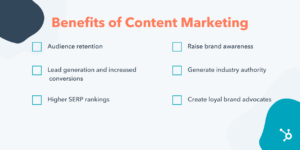Content Marketing: Your Secret Weapon for Growth

Introduction:- Content marketing is more than just a digital trend & Part of Digital Marketing; it is a long-term strategy to build a long-lasting connection between businesses and their target audiences. A brand can establish authority, increase trust, and drive profitable customer action by creating valuable, relevant, and consistent content. In this article, we will cover what content marketing is, the various types it encompasses, the key benefits, and how it can contribute to the growth of your business.

What is Content Marketing?
Content marketing is designing, creating, sharing, and distributing valuable, relevant, and consistent content to attract and retain a clearly defined audience. In contrast to traditional advertising, which is seen as a means of promotion based upon selling, content marketing looks forward to offering value-based advantages, such as access to educative resources fun storytelling, or meaningful industrial insight. The brand stands as a solution where a need or interest should come from the audience while consistently becoming a trusted and recognized source.

Types of Content Marketing
Content marketing can be found in nearly any form under the umbrella of marketing. Since businesses and their goals will vary in what they would like out of content.
- Blogs
- Social Media Content
- Video Content
- Email Newsletter
- E-books and White Papers
- Infographics
- Podcasts
- User-Generated Content (UGC)
1. Blogging -The most important part of Content Marketing
One of the most popular forms of content marketing is blogging. Businesses use blogs to provide helpful information, insights into the industry, and how-to guides relevant to their audience. Regularly updated blogs also improve search rankings and increase website traffic since businesses can target relevant keywords.
2. Social Media Content – Content Marketing
These include Instagram, Twitter, Facebook, and LinkedIn. Companies can use them to share mixed content: quick updates as well as full-blown campaigns that include interactive polls, videos, and graphics. Social media helps brands develop personality, connect directly with followers, and encourage community engagement.
3. Video Content – Content Marketing
Videos are so engaging and effective tools for the communication of complex information in a quick manner. The medium of distribution has been much smoother with YouTube, Instagram, and TikTok. Video marketing can be in the form of product demonstrations, customer testimonials, behind-the-scenes content, and educational tutorials.
4. Email Newsletters – Content Marketing
Email marketing is still a viable tool for lead nurturing and customer retention. A business can use email newsletters to distribute blog posts, product updates, and personalized content directly to subscribers, thus providing a more tailored approach to content delivery.
5. E-books and White Papers
Good content types include e-books and white papers because they contain long-form content that gives in-depth information about a topic. This kind of content is usually gated, where readers are required to provide their email address or fill out a form before accessing the content. E-books and white papers are best for lead generation and building a brand as an authority.
6. Infographics – Content Writing
Infographics are graphics that represent complex information through data, making the task easy and interesting. These are highly shareable and can increase your reach as well as make you visible, particularly on visual-centric platforms like Pinterest and LinkedIn.
7. Podcasts
Podcasts are the most talked-about popular content nowadays, as an alternative to written or visual content. Businesses can use podcasts to discuss industry trends, share expert opinions, or interview thought leaders, helping to build a loyal audience over time.
8. User-Generated Content (UGC)
User-generated content refers to any content created by their clients themselves, such as their reviews, social media posts, and testimonials. This is the reason why building credibility through UGC is highly considered because it increases the degree of engagement and trust in products from potential customers.
Benefits of Content Marketing
Content marketing benefits businesses that include them in their digital strategy significantly.
1. Increases Brand Awareness
It is through content marketing that one can reach his targeted audience and attract them concerning the solutions provided in the content in question. The more they find their answer online, the better chance they have to look through your content; it thereby increases brand awareness and visibility.
2. Builds Trust and Credibility
Consistently providing value to your customers with the information they can utilize makes your brand known as a thought leader within an industry. When people recognize your brand as a trustworthy resource, you have better opportunities to do business with that customer and to be referred by that customer.
3. Helps in SEO and Organic Search Rankings
- Such great content about the relevant keyword of your webpage increases the website’s visibility in major search engines, where your potential customers can find you easily. For example, blogging on your site will bring fresh content to the preference list of a search engine which increases your chance to come on page one.
- It may include e-books, gated articles, or webinars, capturing good leads and getting access to contact details of users if the content is highly needed by these users, where after such exchange, such leads can further be moved up the sales funnel by subsequent targeted content.
4. This fosters Customer Engagement
Content marketing provides a channel through which a conversation can be opened with the target audience. Direct conversations are enabled on social media, while people share their thoughts and opinions in the comment sections of blogs. Such relationships foster loyalty.
5. Encourages Conversion
Purchase influence is the most important role of content marketing since it addresses the objections and answers questions demonstrating value to the readers. This makes the customers more probable paying customers.
6. Low-Cost Marketing Solution
Content marketing can be less expensive than other advertising since it leverages organic channels for blogs and social media, among others. At some point, you will have a constant stream of traffic and leads without any spending from ads.
7. Customer Retention Improves
The good contents keep the customers glued and interested in your brand, and the consistent value-added posts after the purchase help reaffirm the value that one gets from your product or service, which means an increase in repeat business.

Why do businesses need Content Marketing?
To gain the benefits of using content marketing, you’ll need to have a strategy and one that is well-designed.
1. Definition of Goals
First, you must identify what you’ll aim to achieve with this strategy. Some of them could include increased brand awareness the ability to drive website traffic and leads or even conversive power.
2. Know your audience
You have to know who you are talking to. Research their likes, needs, and pain points. Then, develop buyer personas so you can better examine your target audience.
3. Content Plan
Determine what kind of content you’re going to create and what your posting frequency is going to be. Mix in all different formats of content-from blog posts to videos and social media updates based on what your audience likes and how they consume it.
4. SEO Optimization
Conduct keyword research and use these words organically in the content. The more SEO-friendly the content is, the higher the likelihood that it will rank with search engines. Therefore, you are more likely to find your target audience.
5. Engage Your Audience: Publish Your Content
Spread your words effectively. Like making the content, promotion is as important. Use social media, email newsletters, and partnerships among other channels to reach out to your audience.
6. Monitor and Improve
Regularly check the performance of your content marketing using analytics tools. Use metrics such as traffic, engagement, and conversion rates to identify what is working and what is not so adjustments can be data-driven.

Conclusion
Content marketing is one of the most powerful strategies used in building relationships, creating awareness about a brand, and fostering long-term growth for any business. It creates an authoritative position for your brand among the audience, allowing your brand to gain loyal customers by making valuable content related to their needs. So, whether you’re just starting or enhancing your current efforts, content marketing will give your business long-lasting results.





